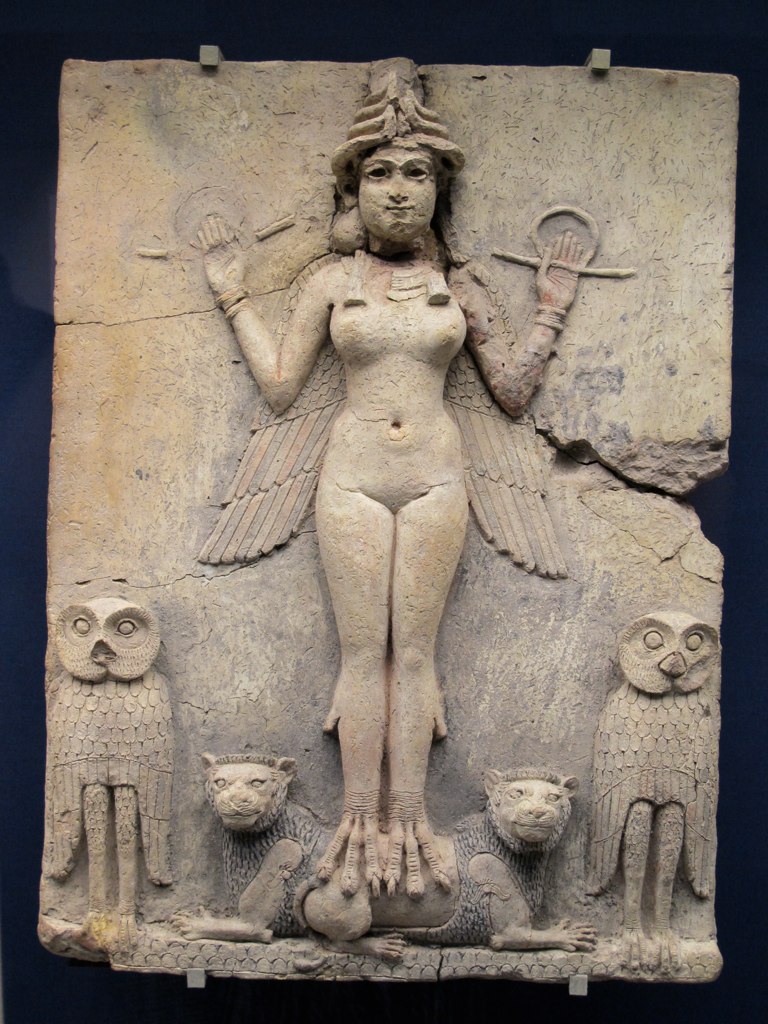Prostitute Priestesses

By Shruti Kothari
Staff Writer
28/7/2020

Late last year, the Sex Workers Outreach Project USA, dedicated to the rights and wellbeing of those in the sex trade, launched the empowering Sacred Whore Line, saying that “in the past, prostitution and spirituality were one and the same…communing sexually with workers and healers was communing with The Divine.” Many in the trade seek validation by hearkening back to those priestesses of yore, who fused the sacred and the profane, sharing their bodies in the service of goddesses. I get it; prejudice against whores exists in just about every culture, and often stems from religious beliefs, so the sacred whore is the perfect answer. However, history isn’t as simple as that, and glorifying her as the ancient symbol of female empowerment is damaging.
While academics argue over the precise meaning of temple prostitution, their existence, especially in West and South Asia, is well-documented. These women were attached to a temple and sexually serviced visitors in the name of religion for a price, the proceeds often accruing to the temple rather than to them. They were kind of the opposites of Vestal Virgins, who were supposed to retain their chastity on pain of being buried alive.
One of the earliest instances of a harimtu or temple prostitute is Shamhat, from the Epic of Gilgamesh. A priestess of the goddess Ishtar, she famously brought the wild man Enkidu to sophistication by having sex with him for six days and seven nights. By the end of it, he is “utterly depleted…diminished,” but no longer a feral beast. Many celebrate Shamhat’s civilizing effects, which include both her body and her generous descriptions of big city life. Her value extends beyond the physical, then, although barely; he was changed before she uttered her first word to him. Worse, she’s commanded to sleep with Enkidu by both Gilgamesh, demi-god-king of Uruk, and a common trapper, who tell her,
“Expose your sex so he can take your voluptuousness,
Do not be restrained – take his energy!
…Spread out your robe so he can lie upon you,
And perform for this primitive the task of womankind!”

Enkidu & Shamhat by Līga Kļaviņa
She shows no agency. Gilgamesh, who at this point in the story is not given much description aside from being a letch who “does not leave a girl to her mother, the daughter of the warrior, the bride of a young man,” is described by Shamhat as “wise to perfection.” She is hardly the embodiment of female empowerment. Shamhat isn’t given any real recognition beyond her ability to do the deed that defines her sex. We see this theme over and over throughout history; whether a man’s goal is to find civilization, cleanse himself of his sins, or encourage fertility in his lands, the temple whore’s elevated standing does not come from her independent identity, like in the case of the courtesan. Her entire value comes from either being licit access to prostitution, or her ability to act as a gateway for men to cross to get to the real prize.
The temple whore’s entire value comes from either being licit access to prostitution, or her ability to act as a gateway for men to cross to get to the real prize.
Sure, many temple prostitutes were given status and rights beyond that of other women of their time. Nancy Qualls-Corbett wrote in her book, The Sacred Prostitute: Eternal Aspect of the Feminine, that “in the code of Hammurabi, special legislation protected the rights and good name of the sacred prostitute.” She was protected from slander, like a married woman, and could inherit property from her father. If she lived away from the temple, she could not run a wine shop, on pain of death, lest she be mistaken for a common prostitute. Here we see another issue: the vast distinction between holy whores and your run-of-the-mill harlot. Not all prostitutes were protected, making the divinity of female promiscuity dependent on circumstance, rather than the act of sex itself.
That brings us to perhaps the biggest question: how did one become a sacred prostitute? The answer to that is never personal choice. They were typically inducted at a young age, usually pre-pubescent. The daughters of temple prostitutes often went on to follow in their mothers’ footsteps. They could also be sold to temples by their parents. According to Marten Stol in Women in the Near East, a tablet from the ancient Mesopotamian city of Nuzi shows a father paying off his debt by dedicating his daughter to a temple of Ishtar “to be used for whoredom.” In South India, the institution of devadasis, literally “maids of god,” is still rife at some Hindu temples, despite being outlawed in 1988. A study showed that reasons for girls becoming temple prostitutes included dumbness, deafness, and poverty. In Nepal, poor families who cannot feed their daughters will donate them to Hindu temples that maintain the tradition; as described in Modern Slavery: A Beginner’s Guide, rich families might purchase such daughters for donation, too. There is evidence to suggest that grown women were forced into temple prostitution in some Roman provinces as punishment for adultery.

Relief, believing to depict Ishtar, British Museum
One popular account from Herodotus claimed that in ancient Cyprus all women had to undergo a kind of initiation, where they sat at the temple of Aphrodite and waited for strangers to choose them, pay them any amount, and deflower them. The prettiest girls finished quickly and went home; others might have to wait for years to complete this “sacred duty.” Although this was a one-time thing, it certainly counts as prostitution, and, despite money changing hands, it also falls under sexual slavery. Herodotus may be a questionable source, known for his tall tales, but the historian Sir James Frazer explained that there are enough accounts of similar practices throughout West Asia to suggest there was at least a grain of truth to his assertions.
Of those who did serve as hierodulic prostitutes as a lifestyle rather than initiation ceremony, there is no evidence to suggest that they were able to quit, and so were in fact sex slaves. As part of a documentary, Journeyman Pictures interviewed some modern-day devadasis, who described how first, they were used by temple priests and high-caste men of decreasing status, until at last, turned into liabilities, they were cast out into the street to become profane prostitutes. There, they would ply their trade for as little as 50 cents a time. While some do take pride in their work, which may enable them to support their families and be financially independent, the life expectancy of these abandoned devadasis is tragically low, due to poverty, the oft-dangerous nature of their work, and sexually-transmitted infections. Often, their earnings are given to male relatives, who continue to feed the cycle of child prostitutes and pimp parents.
As the inmate Red from the TV series Orange is the New Black states, “you take a woman’s power away. Her work, her family, her currency…You leave her with one coin…the one she was born with. It may be tawdry and demeaning, but if she has to, she will spend it.” While temple prostitution may have given its servants a higher meaning by infusing their sexual slavery with religiosity, the distinct lack of personal agency, albeit in a modern context, is disjointed from the powerful priestess archetype that we sometimes imagine.
The distinct lack of personal agency, albeit in a modern context, is disjointed from the powerful priestess archetype that we sometimes imagine.
The harm in our romanticized visions is not to do with rewriting history, but rather, condoning current forms of degradation or debasement as some kind of holy act rooted in tradition. The danger concerns both extant servants, like the devadasis, and new cults, like The Family International (TFI), which was founded in California in the 60s, and may have spread to over 100 countries at its peak. TFI coerced especially its female members, using passages from the Bible, into believing that “flirty fishing,” or using their bodies to attract new members, was an act in service of God. There are dozens of unsettling interviews and accounts that report rampant sex trafficking across borders, incest, physical and sexual abuse, and brainwashing, all in the name of Jesus.

The Birth of Venus by Sandro Botticelli
A better way to reconcile religion with empowering female sexuality is to cultivate a new culture of consent based on the ancient goddesses themselves, rather than their priestesses. We are breaking with millennia of hegemonic masculinity; for the most part, the only truly free ancient women, not bound within patriarchal frameworks, were mythical. In a sense, however, they are closer to us than real women of the past. Enjoying the power of choice, they overtly find pleasure in coitus. The Hindu goddess Rati embodies sexual pleasure. Aphrodite seduced countless lovers to sate her desires. Ishtar herself was a whore; there are carvings of her seated in poses typical of prostitutes, and hymns in which she says, “a prostitute compassionate am I.” There are vast amounts of literature dedicated to her enjoyment of her own womanliness. Indeed, a hymn to her goes:
“Gather together for me the men of your city,
And let us go to the shade of the city wall.
Seven on her neck, seven on her hips,
Sixty plus sixty are satisfied by her vessel.
The men become exhausted, but not Ishtar:
‘Men! Set upon my fine vulva!’”
